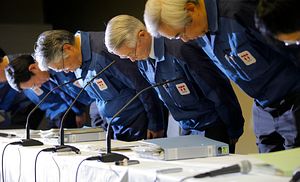Prosecutors at Tokyo Metropolitan District Court continue to piece together the timeline that led Fukushima Daiichi Nuclear Power Plant operator Tokyo Electric Power Company (TEPCO) to hold off on securing the plant against its worst-case tsunami scenario.
Despite TEPCO staff being assigned to calculate the extent of the tsunami threat, their findings were ignored. Top TEPCO officials are now fighting criminal negligence charges for allegedly neglecting tsunami prevention initiatives.
Experts say the impact of the devastating tsunami that struck on March 11, 2011, triggering the Fukushima nuclear meltdown, could have been prevented if sufficient countermeasures were taken. The lengthy criminal trial finished its 32nd session in late October, revealing contradictions in the managerial awareness of the long-term tsunami risks and a controversial shift in the company attitude toward installing appropriate measures.
Former CEO Tsunehisa Katsumata, 78, and former Executive Vice Presidents Sakae Muto, 68, and Ichiro Takekuro, 72, were indicted two years ago on charges of professional negligence resulting in death. All three have pleaded not guilty based on the uncertainty of predicting an “unthinkable” earthquake, which could occur once every thousand years.
Muto bowed his head in front of the judge and offered an apology to those who lost their lives, their families, and those forced to evacuate. From the outset, his initial apology seemed like an admission of responsibility. But it didn’t take long for Muto to maintain his innocence, saying he didn’t recall being briefed on a destructive earthquake or the need for new safety steps.
However, the cross-examination of witnesses at previous court sessions exposed holes in Muta’s pre-hearing affidavit and his statements made in court. TEPCO official Kazuhiko Yamashita, in charge of anti-earthquake measures at the time, gave evidence saying all three officials joined an imperial court meeting in February 2008, where they acknowledged the prediction of a 7.7-meter high tsunami and instructed the building of a 10-meter seawall. The meeting is said to have stressed that new tsunami measures were needed at Fukushima Nuclear Plant based on the long-term evaluation of the country and a hard copy of the report was also distributed to officials. However, in Muto’s affidavit, he originally claimed there was “absolutely no report” and vehemently denied tsunami countermeasures for Fukushima Nuclear Plant were a topic of discussion in the meeting,
An unexpected policy shift away from tsunami preparedness materialized when the TEPCO civil engineering team recalculated the tsunami height risk to 15.7 meters. The team reported the findings to Muto in June the same year. Rather than accelerating earthquake resistance plans, however, as construction proposals ballooned from original estimates and with the risk of unwanted attention on the nuclear power plant’s safety prospects, Yamashita says he was given orders by Muto to scrap the plans. Muto then consulted the Japan Society of Civil Engineers to reassess the findings for a second opinion.
Muto explained in court that he was uncertain of the report’s credibility and that it was natural to gather information on the many aspects he couldn’t make sense of. He repeatedly denied that the move indicated a desire to postpone new safety measures but said it stemmed from lack of alternatives. According to Muto, he didn’t have authority to make decisions over the company in that way.
The Great Eastern Earthquake of March 2011 knocked out power supplies and damaged back up generators, causing vital cooling systems at the nuclear plan to fail. Three reactor cores overheated and began to leak radiation. Seven years on, some 40,000 residents who were forced to flee their homes in Fukushima prefecture are still unable to return to their houses, which have fallen to ruin in the no-go zone. The ongoing trial, propelled largely by a group of Fukushima plaintiffs, offers a small chance at gaining closure and much needed background into the Fukushima nuclear disaster.

































